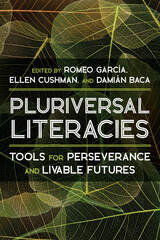154 scholarly books by Diaphanes and 12
start with D
154 scholarly books by Diaphanes and 12
154 scholarly books by Diaphanes
12 start with D start with D
12 start with D start with D
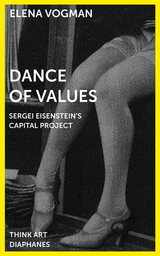
Dance of Values
Sergei Eisenstein’s Capital Project
Elena Vogman
Diaphanes, 2018
Sergei Eisenstein’s cinematic adaptation of Karl Marx’s Capital was never realized, yet it has haunted the imagination of many filmmakers, historians, and philosophers to the present day. Dance of Values aims to conjure the phantom of Eisenstein’s Capital, presenting for the first time material from the full scope of the film project’s archival body. This “visual instruction in the dialectical method,” as Eisenstein called it, comprises more than five hundred pages of notes, drawings, press clippings, diagrams, negatives, theoretical reflections, and extensive quotations. Dance of Values explores the internal formal necessity underlying Eisenstein’s artistic choices, and argues that its brilliant adaptation of Marx’s Capital relied on the fragmentary and nonlinear state of its material. Published here for the first time, sequences from Eisenstein’s archival materials are presented in this volume not as mere illustrations but as arguments in their own right, a visual theorization of value.
[more]
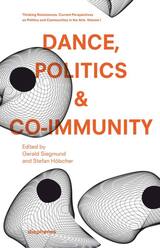
Dance, Politics & Co-Immunity
Current Perspectives on Politics and Communities in the Arts Vol. 1
Edited by Stefan Hölscher and Gerald Siegmund
Diaphanes, 2013
This volume is dedicated to the question of how dance, both in its historical and in its contemporary manifestations, is intricately linked to conceptualisations of the political. Whereas in this context the term "policy" means the reproduction of hegemonic power relations within already existing institutional structures, politics refers to those practices which question the space of policy as such by inscribing that into its surface which has had no place before. The art of choreography consists in distributing bodies and their relations in space. It is a distribution of parts that within the field of the visible and the sayable allocates positions to specific bodies. Yet in the confrontation between bodies and their relations, a deframing and dislocating of positions may take place. The essays included in this book are aimed at the multiple connections between politics, community, dance, and globalisation from the perspective of e.g. Dance and Theatre Studies, History, Philosophy, and Sociology.
[more]
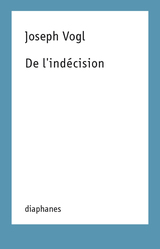
De l'indécision
Joseph Vogl
Diaphanes, 2016
À partir des réflexions proposées par Freud dans le Moïse de Michel-Ange, Joseph Vogl développe une théorie de l’indécision et présente dans le même temps un véritable système pour explorer cette notion dans toutes ses variantes et ses nuances : dans le glissement synonymique entre hésiter, tergiverser, osciller, rechigner, chanceler ou vaciller s’exprime un doute profond, une démarche inquiète, un recul. Pourtant, la perplexité implicite de cette hésitation n’implique pas tout simplement l’arrêt d’une action. Elle indique tout d’abord le seuil imperceptible entre action et non-action, un interstice régi par la pure contingence et la potentialité créatrice. En tant qu’acte de parole à la fois impuissant et résistant, l’indécision introduit une temporalité suspendue qui s’oppose au primat de l’acte posé par la culture occidentale.
Pour Joseph Vogl, un événement est toujours inscrit dans un ensemble stratifié formé par l’ensemble de ses variantes non réalisées. Sa recherche esthétique et historique attribue ainsi à l’indécision une place posée comme systématique : elle instaure une « méthode de complication » par laquelle le pouvoir discursif des événements historiques et politiques peut être interrogé et contenu. Considérée comme une attitude face au monde et un geste de mise en question radicale, la temporalité suspendue de l’indécision constitue enfin le champ opératoire du discours lui-même.
Dans ce petit essai brillant et érudit, Vogl retrace une « anti-histoire » de l’indécision qui apparaît surtout en littérature et prend corps à travers les siècles dans les personnages d’Oreste, de Wallenstein, de Joseph K., de Bartleby ou de l’homme sans qualités.
Pour Joseph Vogl, un événement est toujours inscrit dans un ensemble stratifié formé par l’ensemble de ses variantes non réalisées. Sa recherche esthétique et historique attribue ainsi à l’indécision une place posée comme systématique : elle instaure une « méthode de complication » par laquelle le pouvoir discursif des événements historiques et politiques peut être interrogé et contenu. Considérée comme une attitude face au monde et un geste de mise en question radicale, la temporalité suspendue de l’indécision constitue enfin le champ opératoire du discours lui-même.
Dans ce petit essai brillant et érudit, Vogl retrace une « anti-histoire » de l’indécision qui apparaît surtout en littérature et prend corps à travers les siècles dans les personnages d’Oreste, de Wallenstein, de Joseph K., de Bartleby ou de l’homme sans qualités.
[more]
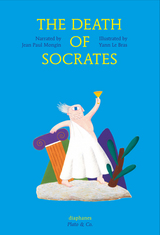
The Death of Socrates
Jean Paul Mongin and Yann Le Bras
Diaphanes, 2015
At its most basic, philosophy is about learning how to think about the world around us. It should come as no surprise, then, that children make excellent philosophers! Naturally inquisitive, pint-size scholars need little prompting before being willing to consider life’s “big questions,” however strange or impractical. Plato & Co. introduces children—and curious grown-ups—to the lives and work of famous philosophers, from Descartes to Socrates, Einstein, Marx, and Wittgenstein. Each book in the series features an engaging—and often funny—story that presents basic tenets of philosophical thought alongside vibrant color illustrations.
“Tell us, Delphic Oracle, who is the wisest man in all of Greece?” So begins The Death of Socrates. No mortal man is wiser than Socrates, who, on his daily walks through Athens, talks to all the people he meets. When the person he talks to takes himself to be very wise, Socrates asks so many questions that the person ends up admitting he knows nothing. When he runs into people who know little, Socrates sets them on the way to wisdom. But not everyone shares Socrates’s love for the truth. When the people of Athens become angry with him for his ceaseless questioning, how will he find the courage to continue to speak the truth?
Plato & Co.’s clear approach and charming illustrations make this series the perfect addition to any little library.
“Tell us, Delphic Oracle, who is the wisest man in all of Greece?” So begins The Death of Socrates. No mortal man is wiser than Socrates, who, on his daily walks through Athens, talks to all the people he meets. When the person he talks to takes himself to be very wise, Socrates asks so many questions that the person ends up admitting he knows nothing. When he runs into people who know little, Socrates sets them on the way to wisdom. But not everyone shares Socrates’s love for the truth. When the people of Athens become angry with him for his ceaseless questioning, how will he find the courage to continue to speak the truth?
Plato & Co.’s clear approach and charming illustrations make this series the perfect addition to any little library.
[more]

Dialogical Imaginations
Aisthesis as Social Perception and New Ideas of Humanism
Edited by Michael F. Zimmermann with Gernot Müller, Christian Sauer, Kerstin Schmidt, Robert Schmidt, and Fosca Mariani Zini
Diaphanes
We tend to think of imagination as private, originating from our innermost selves—and language as something that is created in communication. Turning this idea on its head, the contributors to Dialogical Imaginations start from the provocative premise that imagination and language are both inherently social constructs that determine how we perceive the world. In addition, the idea of imagination as a dialogical formation, where dialogue within the self can raise questions and can open up new topics for consideration, may also be applied to how societies as a whole perceive their own conditions.
With contributors from a wide range of disciplines, including philosophy, media and film studies, art history, literature, and sociology, the book considers a wide variety of cultural manifestations of social perception. In the process, it offers a reevaluation of he concept of humanism, addressing key criticisms of by Foucault, Butler, and others.
With contributors from a wide range of disciplines, including philosophy, media and film studies, art history, literature, and sociology, the book considers a wide variety of cultural manifestations of social perception. In the process, it offers a reevaluation of he concept of humanism, addressing key criticisms of by Foucault, Butler, and others.
[more]

Diogenes the Dog-Man
Yan Marchand and Vincent Sorel
Diaphanes, 2017
At its most basic, philosophy is about learning how to think about the world around us. It should come as no surprise, then, that children make excellent philosophers! Naturally inquisitive, pint-size scholars need little prompting before being willing to consider life’s “big questions,” however strange or impractical. Plato & Co. introduces children—and curious grown-ups—to the lives and work of famous philosophers, from Socrates to Descartes, Einstein, Marx, and Wittgenstein. Each book in the series features an engaging—and often funny—story that presents basic tenets of philosophical thought alongside vibrant color illustrations.
In Diogenes the Dog-Man, the philosopher Diogenes not only admires the honesty of dogs, he has actually become one—sleeping, eating, and lifting his leg to pee wherever he chooses! Best of all, unlike humans, who dupe one another as to their true feelings, Diogenes the Dog-Man is free to bark his displeasure and even bite his adversaries in the calves—even if they happen to be Alexander the Great. Initially, the citizens gathered in the Agora think Diogenes is mad. Does he have rabies? But it soon becomes clear that we can all learn a thing or two from dogs about how to live a simple life.
In Diogenes the Dog-Man, the philosopher Diogenes not only admires the honesty of dogs, he has actually become one—sleeping, eating, and lifting his leg to pee wherever he chooses! Best of all, unlike humans, who dupe one another as to their true feelings, Diogenes the Dog-Man is free to bark his displeasure and even bite his adversaries in the calves—even if they happen to be Alexander the Great. Initially, the citizens gathered in the Agora think Diogenes is mad. Does he have rabies? But it soon becomes clear that we can all learn a thing or two from dogs about how to live a simple life.
[more]

Disabled Theater
Edited by Sandra Umathum and Benjamin Wihstutz
Diaphanes, 2015
Jérôme Bel’s Disabled Theater, a dance piece featuring eleven actors with cognitive disabilities from Zurich’s Theater Hora, has polarized audiences worldwide. Some have celebrated the performance as an outstanding exploration of presence and representation; others have criticized it as a contemporary freak show. This impassioned reception provokes important questions about the role of people with cognitive disabilities within theater and dance—and within society writ large. Using Disabled Theater as the basis for a broad, interdisciplinary discussion of performance and disability, this volume explores the intersections of politics and aesthetics, inclusion and exclusion, and identity and empowerment. Can the stage serve as a place of emancipation for people with disabilities? To what extent are performers with disabilities able to challenge and subvert the rules of society? What would a performance look like without an ideology of ability? The book includes contributions by Jérôme Bel, Kai van Eikels, Kati Kroß, André Lepecki, Lars Nowak, Yvonne Rainer, Gerald Siegmund, Yvonne Schmidt, Sandra Umathum, Scott Wallin, Benjamin Wihstutz, and the actors of Theater Hora.
[more]

Display, Distribute, Disrupt
Contemporary Moving Image Practices
Edited by Wolfgang Brückle and Fred Truniger
Diaphanes, 2023
An exploration of the digital revolution in traditional audiovisual media.
Over the last two decades, the field of audiovisual media has changed dramatically. Until recently, there was only a small number of technologies, distribution channels were few, and moving images were largely limited to cinemas, televisions, galleries, or art museums. Also, both the producers and the audiences of such content clearly identified as human beings. Those days are over.
The digitization of image production and distribution ushered in a massive disruption to the traditional landscape of the moving image that had existed since the advent of the audiovisual industry. Touching on discussions such as child producers, the marketing interests of big corporations, and the origins of new media formats and practices, Display, Distribute, Disrupt maps the new conditions for creative work in the ever-widening sphere of audiovisual media.
Over the last two decades, the field of audiovisual media has changed dramatically. Until recently, there was only a small number of technologies, distribution channels were few, and moving images were largely limited to cinemas, televisions, galleries, or art museums. Also, both the producers and the audiences of such content clearly identified as human beings. Those days are over.
The digitization of image production and distribution ushered in a massive disruption to the traditional landscape of the moving image that had existed since the advent of the audiovisual industry. Touching on discussions such as child producers, the marketing interests of big corporations, and the origins of new media formats and practices, Display, Distribute, Disrupt maps the new conditions for creative work in the ever-widening sphere of audiovisual media.
[more]
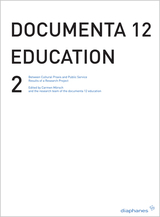
documenta 12 education 2
Between Critical Practice and Visitor Services Results of a Research Project
Edited by Carmen Mörsch
Diaphanes, 2009
»Cultural Education« is much debated. It is pivotal in sustaining a sense of community in a society that is constantly shifting. A space where differences can be explored, art exhibitions act as a superb medium for cultural and aesthetic education. They don‘t aspire to peace and harmony but to stage controversy. They enable multiple models of communication, open to dissent and rupture.
Education is situated in tension between public sphere and institution, amateur and professional, artist and audience. Its development needs felicitous examples as well as rigor in discussing problems towards identifying practical solutions.
»documenta 12 education« presents in two illustrated volumes the education formats with concomitant research, providing a basis for developing theory and praxis of gallery education.
These volumes are an ideal resource for people working in the fields of curating exhibitions, gallery education, youth work and cultural policy. People less familiar with cultural work will find in these books a valuable introduction to the field of gallery education.
Volume 2 focuses on a theory of gallery education, its methods and contexts, and reflects theoretically on examples presented in Volume 1. It is addressed to professionals from the field of gallery education, cultural education and formal education.
Education is situated in tension between public sphere and institution, amateur and professional, artist and audience. Its development needs felicitous examples as well as rigor in discussing problems towards identifying practical solutions.
»documenta 12 education« presents in two illustrated volumes the education formats with concomitant research, providing a basis for developing theory and praxis of gallery education.
These volumes are an ideal resource for people working in the fields of curating exhibitions, gallery education, youth work and cultural policy. People less familiar with cultural work will find in these books a valuable introduction to the field of gallery education.
Volume 2 focuses on a theory of gallery education, its methods and contexts, and reflects theoretically on examples presented in Volume 1. It is addressed to professionals from the field of gallery education, cultural education and formal education.
[more]
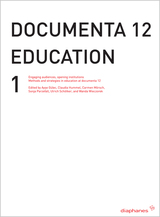
documenta 12 education I
Engaging audiences, opening institutions Methods and strategies in education at documenta 12
Edited by Ayse Güleç, Claudia Hummel, Ulrich Schötker, and Wanda Wieczorek
Diaphanes, 2009
»Cultural Education« is much debated. It is pivotal in sustaining a sense of community in a society that is constantly shifting. A space where differences can be explored, art exhibitions act as a superb medium for cultural and aesthetic education. They don‘t aspire to peace and harmony but to stage controversy. They enable multiple models of communication, open to dissent and rupture.
Education is situated in tension between public sphere and institution, amateur and professional, artist and audience. Its development needs felicitous examples as well as rigor in discussing problems towards identifying practical solutions.
»documenta 12 education« presents in two illustrated volumes the education formats with concomitant research, providing a basis for developing theory and praxis of gallery education.
These volumes are an ideal resource for people working in the fields of curating exhibitions, gallery education, youth work and cultural policy. People less familiar with cultural work will find in these books a valuable introduction to the field of gallery education.
Volume 1 gives a comprehensive and richly illustrated survey of formats and models of education and collaboration with the public at documenta 12.
Education is situated in tension between public sphere and institution, amateur and professional, artist and audience. Its development needs felicitous examples as well as rigor in discussing problems towards identifying practical solutions.
»documenta 12 education« presents in two illustrated volumes the education formats with concomitant research, providing a basis for developing theory and praxis of gallery education.
These volumes are an ideal resource for people working in the fields of curating exhibitions, gallery education, youth work and cultural policy. People less familiar with cultural work will find in these books a valuable introduction to the field of gallery education.
Volume 1 gives a comprehensive and richly illustrated survey of formats and models of education and collaboration with the public at documenta 12.
[more]
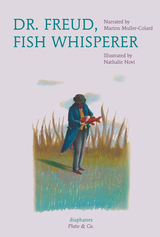
Dr. Freud, Fish Whisperer
Marion Muller-Colard
Diaphanes, 2017
At its most basic, philosophy is about learning how to think about the world around us. It should come as no surprise, then, that children make excellent philosophers! Naturally inquisitive, pint-size scholars need little prompting before being willing to consider life’s big questions, however strange or impractical. Plato & Co. introduces children—and curious grown-ups—to the lives and work of famous philosophers, from Socrates to Descartes, Einstein, Marx, and Wittgenstein. Each book in the series features an engaging—and often funny—story that presents basic tenets of philosophical thought alongside vibrant color illustrations.
Sprawled in his favorite armchair, Dr. Freud notices a peculiar phrase in pages of his notebook: “preaching to the fishes.” What could he have meant by this? If there’s one thing he has learned working as a psychoanalyst, it’s that the best way to make sense of yourself is through your dreams—and so he settles down for a nice long nap. But no sooner does his head hit the pillow than he begins to hear voices! A frightened fish with a childhood memory lodged in its throat coaxes Dr. Freud into the cold water, where his ideas come to life through an unforgettable cast of characters, including a loquacious carp and three frogs—Id, Ego, and Superego—locked in fierce competition for a single waterlily.
Sprawled in his favorite armchair, Dr. Freud notices a peculiar phrase in pages of his notebook: “preaching to the fishes.” What could he have meant by this? If there’s one thing he has learned working as a psychoanalyst, it’s that the best way to make sense of yourself is through your dreams—and so he settles down for a nice long nap. But no sooner does his head hit the pillow than he begins to hear voices! A frightened fish with a childhood memory lodged in its throat coaxes Dr. Freud into the cold water, where his ideas come to life through an unforgettable cast of characters, including a loquacious carp and three frogs—Id, Ego, and Superego—locked in fierce competition for a single waterlily.
[more]
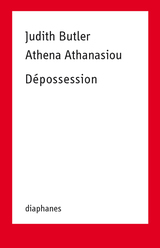
Dépossession
Athena Athanasiou and Judith Butler
Diaphanes, 2016
Dialogue entre Judith Butler et Athena Athanasiou : le débat tourne autour de ceux qui ont perdu leur pays, leur nationalité, leurs biens, tous ceux qui ont été expropriés de leur appartenance au monde. Que signifie cette précarité, cette perte fondamentale, dans une société capitaliste dominée par la logique de la possession ? Est-ce que cette conscience d’expropriation peut amener à une nouvelle forme de résistance, apporter une réponse politique à ceux qui ont été déchus de leurs droits, de leurs biens, en un mot, des conditions de base de la vie elle-même ?
Les soulèvements révolutionnaires au Moyen-Orient et au Maghreb, comme les manifestations sur la place Puerta del Sol, la place Syntagma et le parc Zucotti établissent une nouvelle économie politique et affective du corps dans l’espace public. La rue est l’endroit par excellence des expropriés — de ceux qui défient les forces de police et qui se regroupent spontanément dans des collectifs pour lever la voix, pour être vus et entendus. Le livre offre une introduction à la complexité des nouvelles formes de privation de droits, de dépossession et de contestation politique. Une réflexion sur la puissance du perfomatif ainsi que sur la perte de pouvoir du sujet souverain et moral classique.
Les soulèvements révolutionnaires au Moyen-Orient et au Maghreb, comme les manifestations sur la place Puerta del Sol, la place Syntagma et le parc Zucotti établissent une nouvelle économie politique et affective du corps dans l’espace public. La rue est l’endroit par excellence des expropriés — de ceux qui défient les forces de police et qui se regroupent spontanément dans des collectifs pour lever la voix, pour être vus et entendus. Le livre offre une introduction à la complexité des nouvelles formes de privation de droits, de dépossession et de contestation politique. Une réflexion sur la puissance du perfomatif ainsi que sur la perte de pouvoir du sujet souverain et moral classique.
[more]
READERS
Browse our collection.
PUBLISHERS
See BiblioVault's publisher services.
STUDENT SERVICES
Files for college accessibility offices.
UChicago Accessibility Resources
home | accessibility | search | about | contact us
BiblioVault ® 2001 - 2024
The University of Chicago Press




